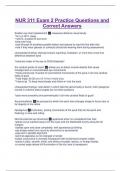NUR 311 Exam 2 Practice Questions and
Correct Answers
Snellen eye chart assessment ✅-measures distance visual acuity
**6 m or 20 ft. Away
**well lit, at patient's eye level
-tests each eye
-read through till smallest possible letters and request to read the line after that
-note if they wear glasses or contacts (should be wearing them during assessment)
Unexpected findings: leaning forward, squinting, hesitation, or more than a two-line
difference between eyes
*refractive index of the eye is 20/20 bilaterally*
Six cardinal points of vision ✅-allows you to detect muscle defects that cause
misalignment or uncoordinated eye movements
**tests extraocular muscles for symmetrical movements of the eyes in all nine cardinal
fields of gaze
**hold finger 30-35 cm (12-14 in) in front of pt.
**instruct pt. To keep head steady and follow w/ only the eyes
Unexpected findings: note deficit in which field the abnormality is found; mild nystagmus
normal in extreme lateral angles but not other positions
*eyes move smoothly and symmetrically in all nine cardinal fields of gaze*
Accommodation ✅the process by which the eye's lens changes shape to focus near or
far objects on the retina
Nystagmus ✅involuntary, jerking movements of the eyes that can be quick and
fluttering or slow and rolling
Normal external eye structures ✅-eyebrows show no unexplained hair loss
-lashes curve outward away from the eyes and are distributed evenly along the lid
margins
-eyelids open and close completely, with spontaneous blinking
-eye shape varies from round to almond but is symmetrical
-eyes are in parallel alignment
-lacrimal apparatus is not enlarged or tender
-bulbar conjunctiva is normally transparent with small blood vessels visible
-sclera is clear, smooth, white, and without exudate, lesions, or foreign bodies
-a normal angle allows full illumination of the iris; lens is transparent
,-iris color is evenly distributed, smooth, and without apparent vascularity; normal
variation mosaic variant
-pupil is black, round, and equal w/ a diameter of 2-6 mm; both pupils constrict directly
and consensually
Abnormal external eye structures ✅-eyebrows have unexplained hair loss (with normal
aging the outer third of the eyebrow thins)
-eyelashes curved inward toward the eye, distributed unevenly along the lid margin, or
both
-eyelids incompletely open or close, no spontaneous blinking, improper positioning w/
respect to iris and limbus
-eye shape asymmetrical
-eyes not in parallel alignment (ptosis)
-lacrimal apparatus enlarged and/or tender
-erythema, cobblestone appearance, purulent discharge, complete redness, and
matting indicate allergy or infection of bulbar conjunctiva
-abnormal thickening (pterygium) of bulbar conjunctiva
-scleral redness, jaundice, bluing, and drainage
-lens cloudiness
-iris color not evenly distributed, noted vascularity
-pupil size less than 1 mm, aniscoria, marcus gunn pupil, argyll robertson pupils, horner
syndrome, and oval pupils
Perrla ✅pupils equal, round, reactive to light and accommodation
Rinne hearing test ✅-evaluates bone conduction versus air conduction of sound in one
ear at a time with a tuning fork
-helps determine whether hearing is equal in both ears and whether a conductive or
snhl is present by allowing you to compare difference in bc and ac
**place base of tuning fork at mastoid process to assess bc
**place two prongs of tuning fork in front of the external auditory meatus
**each time, instruct patient to inform you when they no longer hear the sound
Unexpected findings: bc that is longer or the same as ac is evidence of conductive
hearing loss
*ac is twice as long as bc*
Weber test ✅-hearing test using a tuning fork; distinguishes between conductive and
sensorineural hearing loss (differentiates the cause of hearing loss)
**place on the midline of the parietal bone in line with both ears
Unexpected findings: unilateral identification of the sound indicates sensorineural loss in
the ear which the patient didn't hear the sound
*patient hears the sound in both ears and at equal intensity*
, Whisper test ✅-evaluates for loss of high-frequency sounds
**patient plugs ear not being tested
**nurse stands on side of unplugged ear and uses hand to block their mouth from
patient's view (45 cm or 18 in)
**whisper 3 different words
**patient repeats the words
Unexpected findings: not being able to repeat or missing components may indicate
hearing loss of higher frequencies
*patient repeats all 3 words without error*
Nine regions of the abdomen ✅right hypochondriac, epigastric, left hypochondriac,
right lumbar, umbilical, left lumbar, right iliac, hypogastric, left iliac
Right hypochondriac region ✅liver, gallbladder, right kidney, large/small intestine
Epigastric region ✅liver, stomach, spleen, duodenum, adrenal glands, pancreas
Left hypochondriac region ✅liver's tip, stomach, pancreas, left kidney, spleen,
large/small intestine
Right lumbar region ✅ascending colon, small intestine, right kidney
Umbilical region ✅duodenum, small intestine, transverse colon
Left lumbar region ✅descending colon, small intestine, left kidney
Right iliac region ✅appendix, cecum, ascending colon, small intestine
Hypogastric region ✅bladder, sigmoid colon, small intestine, reproductive organs
Left iliac region ✅sigmoid colon, descending colon, small intestine
Abdominal assessment subjective ✅-indigestion, anorexia, nausea, vomiting?
-abdominal pain?
-difficulty or pain swallowing?
-changes in bowel habits?
-constipation or diarrhea?
-changes in skin color or stool color?
-pain above pubic area?
-experience pain, urgency, or frequency of urination?
-urinate more frequently than usual or during the night?
-involuntary loss of urine?




